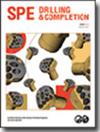深水钻井中独立钻井隔水管力学特性及作业包线研究
IF 1.2
4区 工程技术
Q3 ENGINEERING, PETROLEUM
引用次数: 2
摘要
独立钻井立管(FSDR)是深水钻井领域的一种新型立管,虽然尚未投入商业应用,但与传统立管相比,它可以显著降低工程对恶劣天气的敏感性。近地表断开包的最佳安装深度和最优浮力罐数是FSDR系统中的两个重要参数。本文提出了FSDR系统的关键力学问题,研究了FSDR系统在正常钻井模式和独立钻井模式下的力学特性。以上两个最优参数是根据具体的海洋环境和系统配置计算得出的。通过参数灵敏度分析,确定了FSDR系统的工作包络线。分析结果表明,为了避免强波流剖面,提高FSDR在独立模式下的性能,NSDP应安装在海面以下200 m处。从力学角度来看,FSDR最薄弱的部分位于浮力罐与隔水管接头的连接处,此处应设置应力接头,以改善系统的受力状况。正常钻井模式下FSDR的最大von Mises应力是限制浮力罐数量增加的主要因素。FSDR的正常工作包络主要受上部柔性关节(UFJ)挠度和von Mises应力的限制。根据浮筒的力学特性和作业规范,为保证浮筒在正常钻井模式下的安全,浮筒的最优数量为6个,船距小于水深的2%。最后,对FSDR系统的未来研究提出了建议。本文章由计算机程序翻译,如有差异,请以英文原文为准。
Study on the Mechanical Characteristics and Operating Envelope of Freestanding Drilling Riser in Deepwater Drilling
Freestanding drilling riser (FSDR), a new type of riser in deepwater drilling, though not in commercial use, can significantly reduce the engineering sensitivity to severe weather compared to the conventional risers. The optimal installation depth of the near surface disconnection package (NSDP) and the optimal number of buoyancy cans are two important parameters in the FSDR system. In this paper, the key mechanical problems of the FSDR system have been proposed and the mechanics of the FSDR system in normal drilling mode and freestanding mode have been studied. The above two optimal parameters have been calculated on the basis of a specific marine environment and system configuration. The operating envelope of the FSDR system has been figured out through parameter sensitivity analysis. Analysis results show that the NSDP should be installed 200 m below the sea surface to avoid strong wave-current profile and enhance the performance of the FSDR in freestanding mode. From the mechanical point of view, the weakest section of the FSDR is located at the junction between the buoyancy cans and the riser joints, where stress joint should be equipped to improve the stress condition of the system. Further, the maximum von Mises stress of the FSDR in normal drilling mode is the dominant factor restricting the increase of the number of buoyancy cans. The normal operating envelope of the FSDR is mainly limited by the deflection angle of the upper flexible joint (UFJ) and the von Mises stress. On the basis of the mechanics and operating criteria of the FSDR, the optimal number of buoyancy cans is six and the vessel offset should be less than 2% of the water depth to ensure the safety of the FSDR in normal drilling mode. Finally, suggestions on the future study on the FSDR system have been proposed.
求助全文
通过发布文献求助,成功后即可免费获取论文全文。
去求助
来源期刊

SPE Drilling & Completion
工程技术-工程:石油
CiteScore
4.20
自引率
7.10%
发文量
29
审稿时长
6-12 weeks
期刊介绍:
Covers horizontal and directional drilling, drilling fluids, bit technology, sand control, perforating, cementing, well control, completions and drilling operations.
 求助内容:
求助内容: 应助结果提醒方式:
应助结果提醒方式:


